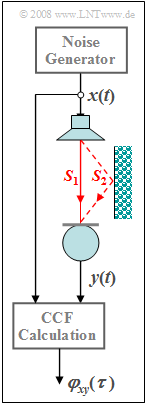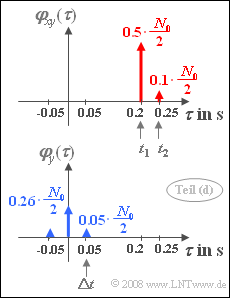Exercise 4.14Z: Echo Detection
From LNTwww
To measure acoustic echoes in rooms – for example caused by reflections at a wall – the adjacent setup can be used:
- The noise generator produces a "white noise in the relevant frequency range" $x(t)$ with power density $N_0 = 10^{-6} \hspace{0.08cm} \rm W/Hz$.
- This is bandlimited to $B_x = 20 \hspace{0.08cm} \rm kHz$ and is given to a loudspeaker.
- The entire measurement setup is designed for the resistance value $R = 50 \hspace{0.08cm} \rm \Omega$.
In the most general case, the signal recorded by the microphone can be described as follows:
- $$y(t) = \sum_{\mu = 1}^M \alpha_\mu \cdot x ( t - t_\mu ) .$$
Here the $\alpha_\mu$ denote damping factors and $t_\mu$ delay times.
Hints:
- The exercise belongs to the chapter Cross-Correlation Function and Cross Power-Spectral Density.
- Use for numerical calculations the parameter values.
- $$\alpha_1 = 0.5, \hspace{0.2cm}t_1 = 200 \,{\rm ms}, \hspace{0.2cm} \alpha_2 = 0.1, \hspace{0.2cm}t_2 = 250 \,{\rm ms}.$$
Questions
Solution
(1) The two-sided power-spectral density ${\it \Phi}_{x}(f)$ is constantly equal $N_0/2$ in the range $\pm B_x$.
- The Fourier transform is the ACF:
- $$\varphi_x (\tau) = {N_0}/{2} \cdot 2 B_x \cdot {\rm sinc} (2 B_x \tau) = 0.02 \hspace {0.08cm}{\rm W} \cdot {\rm sinc} (2 B_x \tau).$$
- Converted from $R = 50 \hspace{0.08cm} \rm \Omega$ to $R = 1 \hspace{0.08cm} \rm \Omega$ one obtains $($multiplication by $R = 50 \hspace{0.08cm} \rm \Omega)$:
- $$\varphi_x (\tau) = 0.02 \hspace {0.05cm}{\rm VA} \cdot 50 \hspace {0.05cm}{\rm V/A}\cdot {\rm sinc} (2 B_x \tau)= 1 \hspace {0.05cm}{\rm V}^2 \cdot {\rm sinc} (2 B_x \tau).$$
- The rms value is the square root of the ACF value at $\tau = 0$:
- $$\sigma_x \hspace{0.15cm}\underline{= 1 \hspace {0.08cm}{\rm V}}.$$
(2) For the cross correlation function (CCF), in the present case:
- $$\varphi_{xy} (\tau) = \overline {x(t) \hspace{0.05cm}\cdot \hspace{0.05cm}y(t+\tau)} = \overline {x(t) \hspace{0.05cm}\cdot \hspace{0.05cm}\big [ \alpha_1 \cdot x(t- t_1+ \tau)\hspace{0.1cm}+\hspace{0.1cm} \alpha_2 \cdot x(t- t_2+ \tau)\big] } . $$
- After splitting the averaging on two terms, we get:
- $$\varphi_{xy} (\tau) = \alpha_1 \cdot \overline {x(t) \hspace{0.05cm}\cdot \hspace{0.05cm} x(t- t_1+ \tau)} \hspace{0.1cm}+\hspace{0.1cm} \alpha_2 \cdot \overline {x(t) \hspace{0.05cm}\cdot \hspace{0.05cm} x(t- t_2+ \tau)} .$$
- Using the ACF $\varphi_x(\tau)$ can also be written:
- $$\varphi_{xy} (\tau) = \alpha_1 \cdot {\varphi_{x}(\tau- t_1)} \hspace{0.1cm}+\hspace{0.1cm} \alpha_2\cdot {\varphi_{x}(\tau- t_2)} = 1 \hspace {0.08cm}{\rm V}^2 \cdot \big[ \alpha_1 \cdot {\rm sinc} (2 B_x (\tau - t_1)) + \alpha_2 \cdot {\rm sinc} (2 B_x (\tau - t_2)) \big].$$
- The sinc–function exhibits equidistant zero crossings at all multiples of $1/(2B_x) = 25 \hspace{0.08cm} µ \rm s$, related to the centers at $t_1 = 200 \hspace{0.08cm} {\rm ms}$ and $t_2 = 250 \hspace{0.08cm} {\rm ms}$. This results in the CCF values:
- $$\varphi_{xy} (\tau = 0) \hspace{0.15cm}\underline{= 0},\hspace{0.5cm}\varphi_{xy} (\tau = t_1)= \alpha_1 \cdot \varphi_{x} (\tau = 0) \hspace{0.15cm}\underline{= 0.5\,{\rm V}^2} ,\hspace{0.5cm} \varphi_{xy} (\tau = t_2)= \alpha_2 \cdot \varphi_{x} (\tau = 0) \hspace{0.15cm}\underline{= 0.1\,{\rm V}^2} .$$
(3) The cross power-spectral density is the Fourier transform of the CCF, just as the power-spectral density $\rm (PSD)$ gives the Fourier transform of the ACF. It holds:
- $${\it \Phi}_{xy} (f) = \alpha_1 \cdot {\it \Phi}_{x} (f) \cdot {\rm e}^{-{\rm j}2 \pi f t_1} \hspace{0.15cm}+ \hspace{0.15cm}\alpha_2 \cdot {\it \Phi}_{x} (f) \cdot {\rm e}^{-{\rm j}2 \pi f t_2}. $$
- Outside of the range $|f| \le B_x$ the power-spectral density ${\it \Phi}_{x}(f)$ – and correspondingly the cross power-spectral density ${\it \Phi}_{xy}(f)$ – is identically zero.
- In contrast, inside this interval holds ${\it \Phi}_{x}(f) = N_0/2$. It follows in this range:
- $${\it \Phi}_{xy} (f) = {N_0}/{2} \left( \alpha_1 \cdot {\rm e}^{-{\rm j}2 \pi f t_1} \hspace{0.15cm}+ \hspace{0.15cm}\alpha_2 \cdot {\rm e}^{-{\rm j}2 \pi f t_2} \right). $$
- It is evident that ${\it \Phi}_{xy}(f)$ unlike ${\it \Phi}_{x}(f)$ is a complex function. For $f = 0$ holds:
- $${\it \Phi}_{xy} (f = 0) = {N_0}/{2} \left( \alpha_1 \hspace{0.15cm}+ \hspace{0.15cm}\alpha_2 \right) = 0.3 \cdot 10^{-6}\hspace{0.05cm}{\rm W/Hz} \hspace{0.15cm}\underline{= 15 \cdot 10^{-6}\hspace{0.07cm}{\rm V^2/Hz}} . $$
(4) Correct are the proposed solutions 1 and 3:
- The Fourier transform of a Dirac-shaped ACF leads to a constant PSD for all frequencies $f$ ⇒ "true white noise".
- This has an infinitely large power, and for the CCF can then be written according to the above graph:
- $$\varphi_{xy} (\tau) = \alpha_1 \cdot { N_0}/{2} \cdot {\rm \delta}( \tau - t_1) \hspace {0.1cm}+ \hspace {0.1cm} \alpha_2 \cdot { N_0}/{2} \cdot { \rm \delta}( \tau - t_2) .$$
- In the frequency domain, no difference is detectable for $|f| \le B_x$ compared to subtask (3) .
- But since "true white noise" is now present, here the cross power-spectral density is not limited to this range.
(5) For the ACF of the echoed signal, $\varphi_{y} (\tau) = \overline {y(t) \hspace{0.05cm}\cdot \hspace{0.05cm}y(t+\tau)}$.
- This ACF $\varphi_{y} (\tau)$ can consequently be represented as the following sum:
- $$\alpha_1^2 \cdot \overline {x(t - t_1) \cdot x(t - t_1+ \tau)} \hspace{0.03cm} + \hspace{0.03cm} \alpha_1\hspace{0.02cm}\alpha_2 \cdot \overline {x(t - t_1) \cdot x(t - t_2+ \tau)} + \hspace{0.05cm} \alpha_2\hspace{0.02cm}\alpha_1 \cdot \overline {x(t - t_2) \cdot x(t - t_1+ \tau)}\hspace{0.03cm} + \hspace{0.03cm} \alpha_2^2 \cdot \overline {x(t - t_2) \cdot x(t - t_2+ \tau)}. $$
- For the first and the last mean:
- $$\overline {x(t - t_1) \hspace{0.05cm}\cdot \hspace{0.05cm}x(t - t_1+ \tau)} = \overline {x(t - t_2) \hspace{0.05cm}\cdot \hspace{0.05cm}x(t - t_2+ \tau)} = \overline {x(t ) \hspace{0.05cm}\cdot \hspace{0.05cm}x(t + \tau)} =\varphi_x(\tau).$$
- In contrast, for the second and third mean values, we obtain with $\Delta t = t_2 - t_1= 50 \ \rm ms$:
- $$\overline {x(t - t_1) \hspace{0.05cm}\cdot \hspace{0.05cm}x(t - t_2+ \tau)} = \overline {x(t ) \hspace{0.05cm}\cdot \hspace{0.05cm}x(t + t_1- t_2+ \tau)} =\varphi_x(\tau - \Delta t),$$
- $$\overline {x(t - t_2) \hspace{0.05cm}\cdot \hspace{0.05cm}x(t - t_1+ \tau)} = \overline {x(t ) \hspace{0.05cm}\cdot \hspace{0.05cm}x(t + t_2- t_1+ \tau)} =\varphi_x(\tau + \Delta t).$$
- Total, this again results in a symmetric ACF, as shown in the graph below:
- $$\varphi_{y} (\tau) = {N_0}/{2} \cdot \left[ ( \alpha_1^2 \hspace{0.1cm} + \hspace{0.1cm} \alpha_2^2 ) \cdot {\rm \delta} (\tau) \hspace{0.1cm} + \hspace{0.1cm} \alpha_1 \cdot \alpha_2 \cdot {\rm \delta}(\tau - \delta t) \hspace{0.1cm} + \hspace{0.1cm} \alpha_1 \cdot \alpha_2 \cdot {\rm \delta}(\tau + \Delta t) \right].$$
- $$\Rightarrow \hspace{0.3cm}\varphi_{y} (\tau = 0 ) \hspace{0.15cm}\underline{= 0.13 \cdot 10^{-6}\, {\rm W/Hz}}, \hspace{0.3cm}\varphi_{y} (\tau = \Delta t )\hspace{0.15cm}\underline{ = 0.025 \cdot 10^{-6}\, {\rm W/Hz}}.$$

